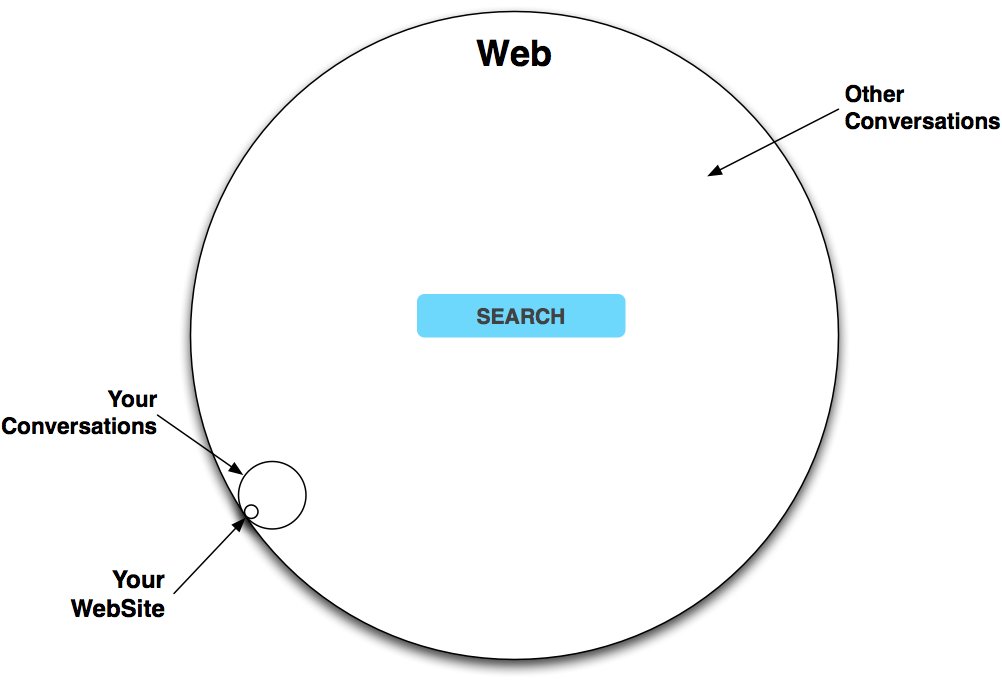Where do you think your website sits on the Web?
The folks over at Hubspot and have been quite vocal when advocating the benefits of inbound marketing over outbound marketing. They are not alone. Real-world marketing experiences reported by the Content Marketing Institute (CMI) demonstrate how companies that have embraced inbound marketing are enjoying greater digital successes with less investment. The CMI have also highlighted how marketing failures are being made by those organisations that do not understand the new conversation rules and/or the lay of the “social” land. But why?
Partly perspective. There are two interesting views taken by traditional marketers (outbound) over content marketers (inbound). The former tends to market their product/services as if their website occupies a central position on the Web with an audience just waiting to be sold at. Sadly, this is not the case. Inbound marketers are more pragmatic in their outlook and understand that your website occupies a very small piece of space on the outskirts of Web. This simple but humble perspective makes all “marketing” the difference.
Your website is not the centre of the universe.
The New World View Explained @ The SmartBoard from Tippingpoint Labs on Vimeo.
Andrew Davies (see above) over at Tipping Point Labs is on the money when he positions your website as the Pluto within the Internet universe. Not surprisingly, the real centre of the universe is search. Because, that’s pretty much where most of us start our journeys these days. Whether we’re trying to buy something (via google), getting opinions from trusted peers and friends (via social media), or performing more topic based searches via brand aggregators (e.g. kosmix), we search to find. That means every day your website is competing with some pretty well established players out there simply to get heard.
So your website is Pluto, now what?
Inbound marketing activities try to shine a light on your website that can be seen by your target audience. From this perspective, the following observations immediately present themselves:
- Your homepage is not as important as you once thought it was. ALL pages are important.
- The majority of the conversations about your brand take place off-site.
- Social media is essential for starting/continuing/facilitating off-site conversations.
- Useful and accessible content attracts relevant and interested audiences.
When you roll all of the above points together, it completely changes the way you approach digital projects. Yes design is important, but it must be informed by content. As Jeffrey Zeldman puts it, “design without content is decoration”. He goes on to observe that:
Content has the same relationship to design that product has to advertising. Good ads are based on the product; good designs come from and facilitate the content.
It is not surprising then that content strategy is becoming a key upstream and central activity within successful, long term, web projects. When project teams on-board content strategy, that’s when the shake up really begins because difficult questions get asked upfront. Historically, those companies that are willing to listen, take stock and act were in the minority but through hard (expensive) lessons this is starting to change.
Embrace your Plutoness
So figure out what your customers need. Understand how you can improve their lives both with and without the products/services you offer. Do the strategic marketing thinking. Not easy, but when done it’s time to use marketing technology to amplify, facilitate and monitor the conversation. At that point, a marketing technology platform provides a cohesive set of tools and techniques to keep marketing in marketing. Integrate disparate solutions. Aggregate partitioned data. Manage cross channel activities. And ultimately make life simpler and more transparent for marketers. That’s the dream.
What do you think? How do you deal with being a Pluto?


